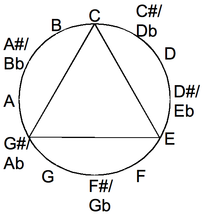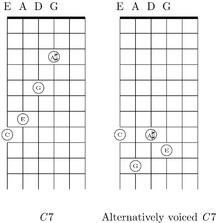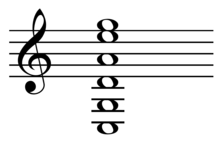Guitar/Alternate Tunings

Many guitar players use alternate tunings, which differ from standard tuning. The use of alternate tunings (non-standard tunings) are found throughout the history of the classical guitar and are a major factor in the playing of blues slide guitar. Many alternate tunings involve downtuning ("dropping") strings.
Dropped tunings
[edit | edit source]Dropped D (DADGBE)
[edit | edit source]The most common alternate tuning is the dropped D (or "drop D") tuning. The lower E string is tuned down to a D. This tuning allows one to play power chords on the fourth, fifth and sixth strings with only one finger, and of course allows for lower bass notes. Used commonly in heavy metal, but also in nearly every other form of guitar music.
Waylon Jennings used this frequently, even dropping to D with the use of a scruggs banjo tuner on his famous telecaster in the middle of a song.
Drop C tuning CGCFAD
[edit | edit source]This progressive tuning is used in metal but often used by bands who stick with 6 string guitars to achieve an extra deep tone. Bands such as CydeDish, Deftones, System of a Down, KSE, August Burns Red and As I Lay Dying.
Drop B (BF#BEG#C#)
[edit | edit source]Alternatively, you can tune to BF#BEG#C#, if you are looking for a deep heavy hitting sound. This tuning is mostly used by nu-metal bands like Slipknot, August Burns Red, many deathcore bands, and some death metal bands.
Drop A (AEADF#B)
[edit | edit source]Alternatively, you can tune to AEADF#B, if you are looking for a deep heavy hitting sound. This tuning is mostly used by nu-metal bands like Slipknot, August Burns Red, many deathcore bands, and some death metal bands.
Double dropped D (DADGBD)
[edit | edit source]Similar to Dropped D above, for this tuning just drop both 'E' strings a full tone. Neil Young often tunes his guitars this way.
Regular tunings
[edit | edit source]


Among alternative guitar-tunings, regular tunings have equal musical-intervals between the paired notes of their successive open-strings. Regular tunings simplify the learning of the fretboard of the guitar and of chords by beginning students. Regular tunings also facilitate improvisation by advanced guitarists.
Guitar tunings assign pitches to the open strings of guitars. Tunings can be described by the particular pitches that are denoted by notes in Western music. By convention, the notes are ordered from lowest to highest. The standard tuning defines the string pitches as E, A, D, G, B, and E. Between the open-strings of the standard tuning are three perfect-fourths (E-A, A-D, D-G), then the major third G-B, and the fourth perfect-fourth B-E.
In contrast, regular tunings have constant intervals between their successive open-strings:
- 4 semitones (major third): Major-thirds tuning,
- 5 semitones (perfect fourth): All-fourths tuning,
- 6 semitones (augmented fourth, tritone, or diminished fifth): Augmented-fourths tuning,
- 7 semitones (perfect fifth): All-fifths tuning
For the regular tunings, chords may be moved diagonally around the fretboard, indeed vertically for the repetitive regular tunings (minor thirds, major thirds, and augmented fourths). Regular tunings thus appeal to new guitarists and also to jazz-guitarists, whose improvisation is simplified. On the other hand, some conventional chords are easier to play in standard tuning than in regular tuning.
Major thirds tuning
[edit | edit source]
[[Image:First and second inversions of C-major chord on six-string guitar with major-thirds tuning.png|right|thumb|alt=The C major chord and its first and second inversions. In the first inversion, the C note has been raised 3 strings on the same fret. In the second inversion, both the C note and the E note have been raised 3 strings on the same fret.|Chords are inverted by shifting notes three strings on the same fret.
Major-thirds tuning was introduced by jazz-guitarist Ralph Patt in 1964. All of the intervals between its successive open strings are major thirds; in contrast, the standard guitar-tuning has one major-third amid four perfect-fourths.
Major-thirds tuning reduces the extensions of the little and index fingers ("hand stretching"). Major and minor chords are played on two successive frets, and so require only two fingers; other chords—seconds, fourths, sevenths, and ninths—are played on three successive frets. For each regular tuning, chord patterns may be moved around the fretboard, a property that simplifies beginners' learning of chords and that simplifies advanced players' improvisation. In contrast, chords cannot be shifted around the fretboard in the standard tuning E-A-D-G-B-E, which requires four chord-shapes for the major chords. There are separate chord-forms for chords having their root note on the third, fourth, fifth, and sixth strings. Major-thirds tuning repeats its octave after every two strings, which again simplifies the learning of chords and improvisation; Chord inversion is especially simple in major-thirds tuning. Chords are inverted simply by raising one or two notes three strings. The raised notes are played with the same finger as the original notes.
All fourths tuning
[edit | edit source]


- E-A-d-g-c'-f'
This tuning is like that of the lowest four strings in standard tuning. Consequently, of all the regular tunings, it is the closest approximation to standard tuning, and thus it best allows the transfer of a knowledge of chords from standard tuning to a regular tuning. Jazz musician Stanley Jordan plays guitar in all-fourths tuning; he has stated that all-fourths tuning "simplifies the fingerboard, making it logical". Contemporary players are also moving to fourths tuning, noted players include Alex Hutchings and Tom Quayle.
- Eb-Ab-Db-Gb-B-E
A less commonly used version of fourths tuning is retaining the regular tuning on the first and second strings (E and B) and lowering the other strings by a semitone. This version can make playing classical pieces more accessible.
Augmented fourths tuning
[edit | edit source]All fifths tuning
[edit | edit source]New Standard Tuning (CGDAEG)
[edit | edit source]
[[Image:C major chord in new standard tuning.png|thumb|left|C major chord in new standard tuning ![]() Play (help·info).]]
Play (help·info).]]

 Play (help·info).
Play (help·info).
 Play (help·info).
Play (help·info).The tuning, invented and introduced by Robert Fripp of King Crimson, is: C(6th) - G(5th) - D(4th) - A(3rd) - E(2nd) - G(1st).
Basically this tuning is efficient because it utilizes the tuning that is common is a cello (CGDA) , violin, and mandolin (both GDAE), in which it is in fifth, from a low C. The second string is a fourth up from the B to an E, and the first string is a minor third up from the E to a G.
Since the lowest five strings are tuned in fifths, typical fingerings for chords and scales used on the violin, cello, and mandolin are applicable here. The minor third between the top strings allow denser chords in the high range of the scale, and easier access to some elementary chord tones (typically the thirteenth for chords with the root note on the sixth string, and the ninth and flat ninth for chords with the root note on the fifth string, see chord). NST has a greater range than the Old Standard Tuning, approximately a perfect fifth (a major third lower and a minor third higher).
Scales across two strings in NST also line up nicely into coherent tetrachords or four-note patterns that have a visually rational relationship (whole and half-tone relationships have a remarkable symmetry that can be easier to learn than the OST whose intervals from 6 to 1 have the (inconsistent) major third thrown in the middle of the scale.
Open tunings
[edit | edit source]Open A (EAC#EAE)
[edit | edit source]Alternatively you could tune the guitar to EAC#AC#E
"Slide" Open A (EAEAC#E)
[edit | edit source]This tuning is identical to Open G tuning but with every string raised one step, or two frets
Open C (CGCGCE)
[edit | edit source]Used notably by Devin Townsend in his bands Strapping Young Lad and Devin Townsend Project.
Open D (DADF#AD)
[edit | edit source]Open D, like all open tunings, produces a major chord (in this case, D major) when all strings are strummed. Drop the sixth, first, and second strings down two semitones, and the third string one semitone. It is also called "DAD-fad" after its notes.
Uses the same chord shapes as Open E but is easier on a guitar neck as the strings are detuned lessening the tension.
Open D is a common tuning for folk, blues, and slide guitar. A variation of this tuning is open d minor. Open D minor is tuned DADFAD, meaning the only change is that the F# is tuned down to an F.
Chord shapes
[edit | edit source]Here are some handy chord shapes: G/D: (020120) Em7/D: (022120)
Open E (EBEG#BE)
[edit | edit source]Used by Cat Stevens and a popular choice for slide guitarists. Strumming in the open position yields a Emajor chord. You can easily play any chord by barring across the neck at different fret positions. This does however have some disadvantages; mainly that it is slightly more difficult to play minor chords. Some artists overcome this by tuning to EBEGBE. This allows both minor and major chords to be played easily. Because tightening the strings more than is intended can break the strings or put unneeded stress on the neck, many players opt to tune in Open D and put a capo on the second fret; the result is the same.
Open C6 (CACGCE)
[edit | edit source]This tuning is rarely used. It has been used by Jimmy Page on "Bron-Yr-Aur", "Friends", and "Poor Tom". J. M. Smig uses this tuning on "Fingers In The Forest".
Open G (DGDGBD)
[edit | edit source]This is sometimes referred to as "Spanish Tuning", popular with slide guitarists. Tune the 1st and 6th strings down to D, and the 5th string to G.
Keith Richards uses this tuning extensively after 1968. (See Brown Sugar, Honky Tonk Women, Start Me Up) He also removes the 6th string (low E in standard tuning) because the root of the chord is on the 5th string in Open G.
Miscellaneous tunings
[edit | edit source]DADGAD
[edit | edit source]DADGAD (pronounced as a word: "DAD-gad"), one of the most versatile tunings, is named after the tuning of its strings. The sixth, second, and first strings are dropped two semitones to D, A, and D. Strumming all the strings open forms a Dsus4 chord; fretting the second fret of the third string (or muting the third string) produces a D5 chord, or D power chord. Most songs for DADGAD are in D major, or in G major with a capo at the fifth fret. Jimmy Page of Led Zeppelin played Kashmir in this tuning.
DADADD
[edit | edit source]This is essentially one huge power chord. Each string neatly divides the scale in half and it is easy to make simple patterns then repeat them anywhere on the fretboard.
Standard E-flat (EbAbDbGbBbeb)
[edit | edit source]In this tuning, each string is tuned down a half step, or one fret. This is a popular tuning throughout the history of blues and rock, and many modern bands perform with it. Stevie Ray Vaughn frequently used this tuning with heavier strings to get a full, rich tone.
Standard D (DGCFAD)
[edit | edit source]Made popular by death metal band Death. Commonly used in metal today.
Standard C (CFBbEbGC)
Used by John Petrucci on 3 songs from Dream Theater’s Train Of Thought.
